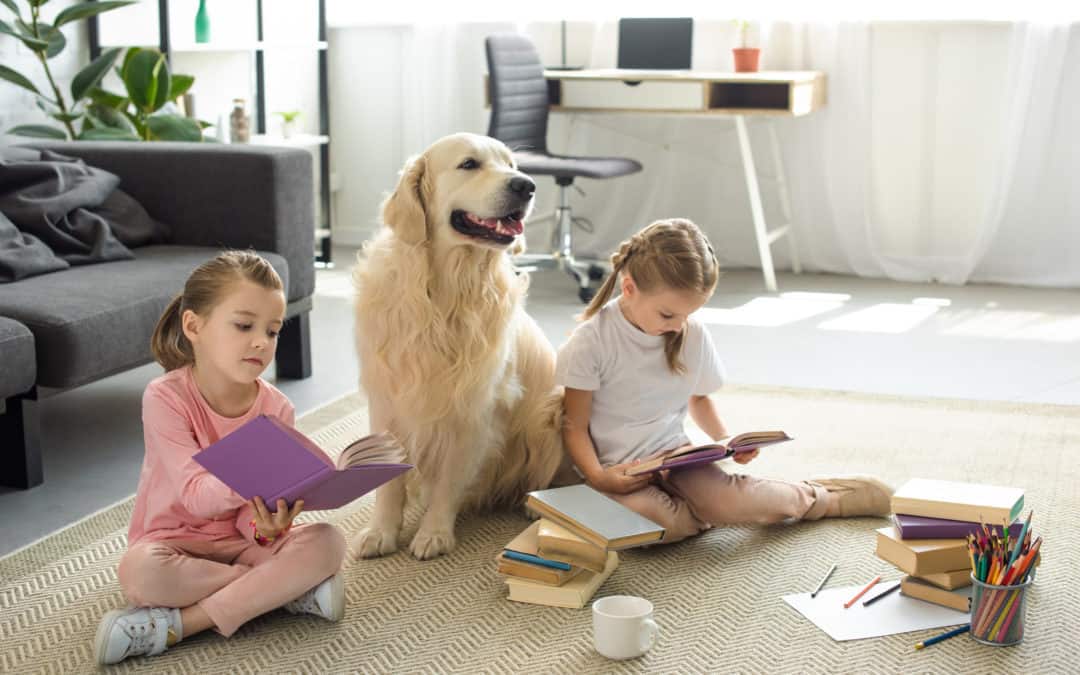We are all having to stay at home for extended periods of time and our routines have completely changed. It’s difficult for everyone, not least your children who now can’t see their friends. Your dog is now having to contend with a complete shift in their world and no understanding of why. With everyone a little out of sorts, tolerance can be in short supply. While arguments between children might end with tears and hurt feelings, arguments between children and dogs are not something to be taken lightly.
Here’s my advice on keeping dogs and children friends while we’re all stuck at home.
Give everyone their own space, including your dog
When we are confined in close quarters with each other for long periods of time we all need some private space and our dogs are no different.
Make sure you have a separate safe place for your dog to retreat to and that you can use if your dog needs a break.
Baby gates on doorways are the perfect way to keep the dog and children separate without complete isolation. If you’ve never used them before, now might be a good time to install one because your dog has never had to live immersed in your family’s company for so long either.
If you can’t install a baby gate then a crate or pen might be a good choice. Make sure you put it up in a quiet spot and that your dog has enough space to stand and turn around in. The bonus is that they are more portable so it’s easy to move them around as you need to.
Give your dog some alone time
We all need a break from each other at times, and we all need to get decent sleep. Make sure your dog is getting some alone time too when he can relax and sleep undisturbed.
Your dog might not be able to completely switch off when the kids are around if he’s used to interacting with them when they are home from school. While he learns that sometimes he can just ignore them and chill, help him out and separate them if he is spending all his time active and not enough time resting.
Dogs spend their days flipping between being active, resting and sleeping normally, help him maintain his normal schedule if needed.
As a bonus ensuring your dog gets some alone time regularly may help him readjust to being left alone when we all go back to normal.
Make sure that all interactions are safe
We all know that children and dogs need to be supervised, but it can be easy to let the rule slide when we are spending more time together and the dog is seeming to love all the attention.
Many bites to children are by the family dog who has just run out of tolerance or is feeling more stressed than usual and there’s just one more thing that is the final straw. Active supervision is paramount, especially when things have changed so much and your dog’s threshold for aggression might be lower than usual.
Safe interaction guidelines are:
- Touching with one hand only. Show your children that one hand on the dog is good but two hands are too much (FamilyPaws.com). This reduces the likelihood of the dog feeling trapped and helps to keep an escape route open for your dog.
- Ask your dog’s consent. Stroke for a few seconds, then stop and take your hands away from your dog. Does your dog move toward you for more? Or move away? Respect your dog’s choice and leave him alone if he has moved away.
- Leave sleeping dogs alone. Even if your dog is normally OK with being woken, he might be more tired right now with the extra activity so have a blanket rule that if he’s asleep to leave him be.
- Always give your dog room to move away. Bites often happen because the dog needed more space and didn’t have a way to get it. Make sure there’s always room for him to move away and respect his choice when he does.
- Watch the resources. You might be using more food toys with your dog now that walks are more curtailed. Let your dog enjoy these by himself where he can’t be disturbed.
Caution during weird or new things
Are you enjoying PE with Joe Wicks in the mornings? Or more arts and crafts projects? Perhaps there’s a spate of DIY going on at home now?
If your dog isn’t used to strange and new activities going on around him then he might get confused, worried or overly excited.
- Exercise. I learned to shut my dogs out of the room when exercising with my bike on a turbo trainer, after a disastrous “knee-smack-cutious-canine” incident. I found myself tangled in the bike on the floor surrounded by three dogs. My dog forgave me, but both he and I were lucky we weren’t injured. Children’s faces at dog level can startle or scare a dog, so give your dog room until you know he can deal with those particular shenanigans. Even then give him time out every once in a while.
- Musical Instruments. Loud musical instruments can distress a dog’s sensitive hearing (not to mention yours and your neighbours. I think our neighbour’s child is learning the recorder….) Have your child practise in another room away from your dog.
- Playtime. If your dog isn’t really used to having the kids running around and playing ball in the garden he is more likely to chase or steal toys. Make that quiet time for your dog inside the house while you all play outside until he can play appropriately. Definitely avoid a situation where your children might be tempted to try and remove toys from dogs mouths.
Involving your children safely
Children can be involved with caring for your dog so they can build a relationship together in appropriate ways.
- Scent games. Hiding treats or toys around the house or garden is generally low risk even for smaller children as you can have the dog in a separate room to set it up if need be. Keep the rules clear that the children hide the treats/toys and your dog finds them – children’s hands shouldn’t be near your dog’s mouth and they shouldn’t be ‘helping’ him find it.
- Retrieve with drop. Throwing toys for your dog to retrieve and drop to the floor for another go is safer than tug or even a retrieve to hand. If your dog often lunges for the toy on the floor when you go to pick it up, the adult needs to collect it or use two toys and adult supervision to play this game.
- Trick training. Really any training is fine but teaching your dog fun silly tricks is often something children enjoy.
- Fill up activity toys. Children can be involved even without contact with your dog by helping you fill all those activity toys you’re now using to keep your dog entertained. They might even come up with some unusual recipes for stuffing in the Kong!

When you see signs of stress
Watch your dog’s body language and look out for those small signs that might indicate your dog is finding the situation a bit stressful. Indicators include yawning, whale eye, head turn away, lip licking, stiff body or shake off. Watch for your dog walking away after an interaction and doing a full body shake off like he’s just come out of the water. This could indicate that what just happened was a bit stressful.
This video from The Family Dog gives some examples of body language to look out for.
If you think your dog is showing signs of stress, give him time and space on his own or away from the main activity for him to chill a bit.
Good resources for safe dog/child interactions are:
- The Family Paws website has some great resources for parents with babies and young children. Their blog in particular has some great articles.
- Stop the 77 by The Family Dog. A great resource on how to prevent dog bites in the home
Get Help
If you are concerned at all, get help from a qualified behaviourist. Even though we cannot see clients in person at the moment, many of us are offering phone or virtual consults via video conferencing and can still help you with any behaviour issues you might be facing.
Tails We Win are conducting virtual consults for private clients, the first step is to tell me what exactly is going on so we can book a telephone consult. Fill in our short online behaviour questionnaire to get things started.

